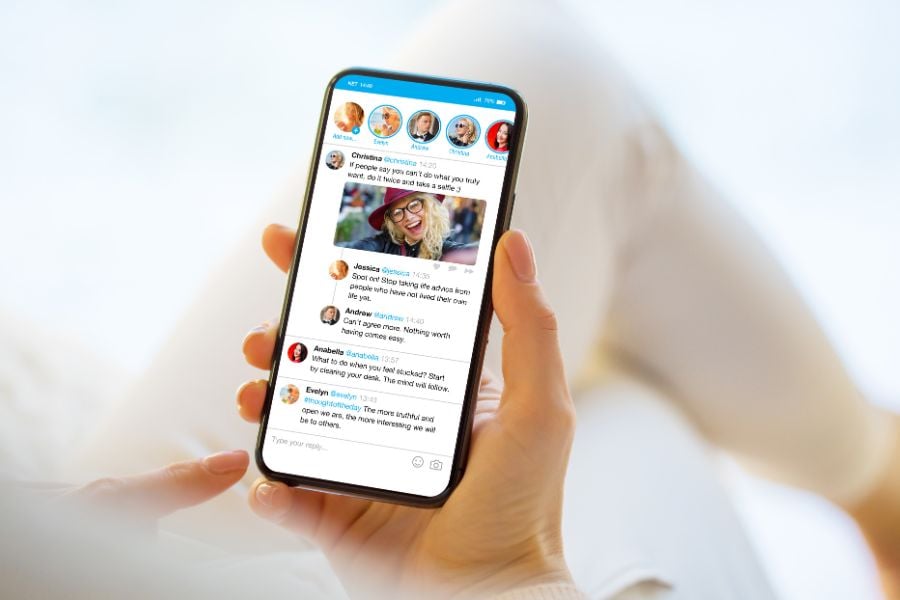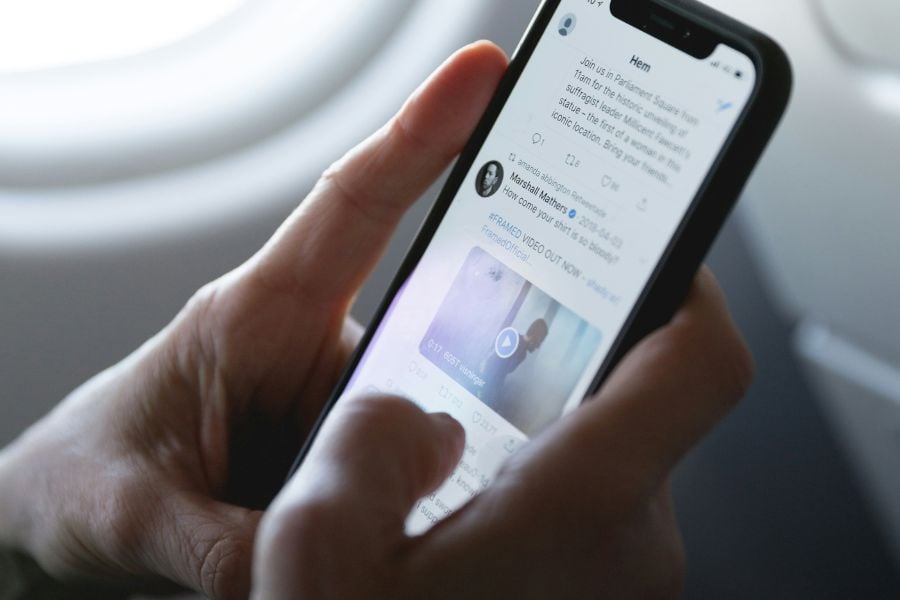X/Twitter is a goldmine of content that can brighten your day, spark your creativity, give your career a boost, or even change your worldview a little.
But how do you increase your chances of finding that valuable life-changing social media content?
In this article, we’ll go over some principles for deciding who to follow, as well as list some of our favorite X/Twitter accounts to inspire, enrich, and edify you!
Ready?
Let’s begin.

Why Curate Your Twitter Feed?
Since its creation in 2006, Twitter (now called X) has evolved from a simple social media platform for sharing short messages to a massive hub for global communication.
It’s now become the go-to source for keeping up with friends, staying updated on the latest trends or current events, finding a like-minded influencer or celebrity, and connecting with virtually anyone under the sun — a real-time information powerhouse.
But let’s be real, X/Twitter can also be overwhelming.
Scrolling through an endless feed stuffed with useless opinions from people you don’t care about is soul-destroying, not to mention a huge waste of time.
This is where curation comes into play. Think of Twitter account curation as putting together a personal playlist but for social media posts.
Following the right people can expose you to new social media marketing strategy ideas, spark inspiration, and connect you with people, industries, and interests that might change everything.
But who should you follow? How do you choose?
How to Choose the Best Twitter Accounts to Follow

Choosing who to follow on X/Twitter is more art than science. But here are some principles for selecting the best accounts for you, specifically…
Relevance
First and foremost, an account should resonate with your personal and/or professional interests. Don’t just follow an account because all your friends are doing so.
Sometimes, following smaller accounts that better resonate with you will be far more valuable than following the so-called “big names.”
At the same time, if an influencer in your niche is getting a lot of attention, it may be worth your time to keep an eye on their content for a while. You can always unfollow them later if you choose to.
Quality of Content
Look for accounts that consistently post engaging, high-quality content. (Not sporadic, irrelevant personal updates).
Both quality and quantity matter if you want to have a constant stream of access to top-notch information that will actually help you succeed in your personal and professional life.
An account that provides valuable insights, shares actionable advice, and sparks new ideas is far more valuable than one that merely parrots common knowledge or thoughtless opinions.
Engagement with Community
Accounts that interact with their X/Twitter followers create a far more valuable X/Twitter experience for everyone.
Social media engagement means these account holders are willing to dialogue, exchange ideas, and learn, which means they will always be growing, which means if you follow them, you can grow along with them.
Authenticity and Credibility
Seek out creators who are transparent, have professional usernames, and have a track record of trustworthiness. Look for signs that the creator has the knowledge and experience to comment on their topic.
And remember that just because someone is successful in one niche does not mean they know what they are talking about in another niche, no matter how confident they sound.
Not to mention, mere academic degrees or job titles are not necessarily indicators of real expertise.
So consider carefully who you take advice from.
Diversity of Perspectives
Don’t let X/Twitter become a mind-shrinking echo chamber. Seek out voices from different sides of every aisle and judge for yourself who has the better take. Actively listen to all sides of an issue before making your own decisions.
The more you consider diverse opinions, the better prepared you will be.
Inspirational Value
It’s fine to follow an account just for the sheer joy, motivation, or inspiration it brings into your life.
Life needs some serendipity in order to be interesting, and you never know when seeing a seemingly insignificant tweet will change you.
23 Top X/Twitter Accounts to Follow in 2024 (& Beyond)

Now, if you’re new to X/Twitter or X/Twitter curation, here are a few recommended accounts, in no particular order, to kick you off:
Best Twitter Accounts for Personal Inspiration
1. Brandon Stanton (@humansofny)
Brandon Stanton, the photographer and storyteller behind Humans of New York, uses his X/Twitter account to share poignant, uplifting, and sometimes heartbreaking stories of people from New York and around the world.
2. Simon Sinek (@simonsinek)
This Start With Why author’s X/Twitter feed features insights on leadership, motivation, and the power of ‘Why.’
In his posts, Sinek encourages X/Twitter followers to think differently about success and how they contribute to the world. Each social media post blends motivational quotes, thought-provoking questions, and inspiring insights.
3. Marie Forleo (@marieforleo)
Marie Forleo‘s X/Twitter account is a goldmine of motivational insights, small business advice, and strategies for creating a life you love.
As a life coach and entrepreneur, Forleo tweets about overcoming self-doubt, turning obstacles into opportunities, and the importance of a growth mindset.
4. Tim Ferriss (@tferriss)
Known for writing “The 4-Hour Workweek,” Ferriss explores productivity hacks, life optimizations, and the routines of high performers in various fields.
His tweets often link to podcasts, articles, and resources that aim to make you more efficient and effective.
5. Naval Ravikant (@naval)
Naval Ravikant is a philosopher-entrepreneur who discusses wealth, happiness, and personal freedom on his X/Twitter feed.
Known for concise yet profound insights, Naval offers a blend of big-picture wisdom and practical advice that encourages deep thinking.
Best X/Twitter Accounts for Professional Insights

6. Gary Vaynerchuk (@garyvee)
Gary Vaynerchuk, aka GaryVee, is a powerhouse of entrepreneurship, digital marketing, and the hustle mentality.
His X/Twitter feed is filled with motivational messages, practical business advice, and personal anecdotes that challenge his followers to pursue their dreams relentlessly and embrace the grind.
7. Justin Welsh (@theJustinWelsh)
Justin Welsh specializes in SaaS (Software as a Service) business strategies but extends his advice to broader topics such as content creation, personal branding, and online business growth.
His social posts are a goldmine for anyone looking to build or scale an online presence with actionable advice.
8. Sahil Bloom (@SahilBloom)
Sahil is known for his ability to distill complex business, economic, and financial concepts into simple, understandable threads.
His account is a valuable resource for anyone looking to deepen their understanding of these areas without getting overwhelmed by jargon.
9. Alex Hormozi (@AlexHormozi)
Business strategist and entrepreneur Alex Hormozi shares advice on wealth creation, sales strategies, business scaling, value creation, and customer acquisition.
His straightforward approach demystifies complex business concepts to be accessible to a wider audience.
10. Adam Grant (@AdamMGrant)
Organizational psychologist Adam Grant delves into the intricacies of work life, creativity, and leadership.
His tweets often challenge conventional wisdom, encouraging critical thinking for those looking to rethink their approach to work and interpersonal relationships.
11. Polina M. Pompliano (@polina_marinova)
Polina Marinova Pompliano’s X/Twitter account features stories on entrepreneurship, wealth building, and the habits of successful people.
Her content blends motivational anecdotes, practical advice, and interviews with successful business people.
12. Pat Flynn (@PatFlynn)
Pat Flynn is a master at making online business approachable. His feed has actionable marketing strategies, passive income opportunities, and personal development tips.
Flynn excels at breaking down complex concepts into digestible, implementable steps for entrepreneurs at all stages of their journey.
13. Neil Patel (@neilpatel)
Neil Patel is a digital marketing expert on everything from SEO and email marketing to content marketing and influencer marketing.
His feed is a hub of practical advice, trend analysis, and growth hacks for marketers and business owners who want to elevate their online presence.
14. Sam Parr (@thesamparr)
Sam Parr, the mind behind The Hustle, shares his journey and lessons in building businesses, investing, and trend-spotting.
His tweets often mix personal anecdotes and predictions with straightforward advice on entrepreneurship.
15. Shaan Puri (@ShaanVP)
Shaan Puri is an entrepreneur and investor whose tweets cover everything from startup strategies to personal wealth building, peppered with his unique insights and experiences.
16. Rand Fishkin (@randfish)
Rand Fishkin, founder of Moz and SparkToro, is an expert in SEO and marketing.
His feed is a blend of industry analysis, marketing ethics, and data-driven insights, ideal for anyone seeking to understand the evolving digital marketing space.
17. Jason Fried (@jasonfried)
Jason Fried, CEO of Basecamp, advocates for a more thoughtful approach to business and work-life balance.
His posts often challenge the status quo of work culture, promoting ideas around remote work, productivity, and company culture.
18. Arvid Kahl (@arvidkahl)
Arvid Kahl focuses on the journey of bootstrapping businesses, sharing insights into product development, customer service, and sustainable growth.
His social media feed combines personal experiences, practical advice, and support for indie developers and entrepreneurs.
Other Unexpected X/Twitter Gems

19. Chris Hadfield (@Cmdr_Hadfield)
Astronaut Chris Hadfield brings the universe closer to us through his X/Twitter feed.
Sharing insights from his time in space, stunning cosmic photography, and thoughts on science and exploration, Hadfield’s account is a gateway to the stars.
His engaging posts educate and inspire a sense of wonder about our universe.
20. Buitengebieden (@buitengebieden)
Primarily known for sharing heartwarming, uplifting, and often breathtaking nature and animal videos, Buitengebieden regularly reminds followers of the beauty in everyday life and the importance of taking a moment to appreciate the world around us.
21. We rate dogs (@dog_rates)
This account celebrates dogs in all their goofy, adorable glory. With humorous, heartwarming ratings of dogs worldwide, We Rate Dogs is a feel-good destination for dog lovers seeking a smile or a laugh.
22. David Perell (@david_perell)
David Perell‘s feed is a treasure trove for anyone who wants to improve their writing and thinking skills.
Perell offers insights into the art of writing, thought-provoking questions, and resources on creativity and productivity.
23. James Breakwell (@XplodingUnicorn)
James Breakwell captures the hilarity of parenting with his witty and relatable tweets.
By sharing conversations with his daughters and observations on family life, he’s created a hilarious resource for parents looking for camaraderie in the chaos of raising children.
Follow The Best X/Twitter Accounts for YOU

So now you’ve got principles AND practical suggestions for finding and following the best X/Twitter accounts for you.
But knowledge is useless until it’s applied. Which means you know what you need to do next…
Open your X/Twitter app and start following people whose work resonates with you! (And unfollowing those who aren’t worth your time.)
This is your opportunity to create a content environment that will help you become the person (or small business) you want to be, and when you join in the conversations, you might just leave your mark on the next X/Twitter follower!



